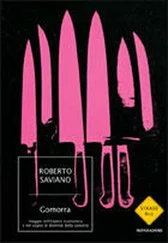Roberto Saviano - Gomorrah - A Personal Journey into the Violent International Empire of Naples’ Organized Crime System
Здесь есть возможность читать онлайн «Roberto Saviano - Gomorrah - A Personal Journey into the Violent International Empire of Naples’ Organized Crime System» весь текст электронной книги совершенно бесплатно (целиком полную версию без сокращений). В некоторых случаях можно слушать аудио, скачать через торрент в формате fb2 и присутствует краткое содержание. Жанр: Старинная литература, на английском языке. Описание произведения, (предисловие) а так же отзывы посетителей доступны на портале библиотеки ЛибКат.
- Название:Gomorrah: A Personal Journey into the Violent International Empire of Naples’ Organized Crime System
- Автор:
- Жанр:
- Год:неизвестен
- ISBN:нет данных
- Рейтинг книги:5 / 5. Голосов: 1
-
Избранное:Добавить в избранное
- Отзывы:
-
Ваша оценка:
- 100
- 1
- 2
- 3
- 4
- 5
Gomorrah: A Personal Journey into the Violent International Empire of Naples’ Organized Crime System: краткое содержание, описание и аннотация
Предлагаем к чтению аннотацию, описание, краткое содержание или предисловие (зависит от того, что написал сам автор книги «Gomorrah: A Personal Journey into the Violent International Empire of Naples’ Organized Crime System»). Если вы не нашли необходимую информацию о книге — напишите в комментариях, мы постараемся отыскать её.
Gomorrah: A Personal Journey into the Violent International Empire of Naples’ Organized Crime System — читать онлайн бесплатно полную книгу (весь текст) целиком
Ниже представлен текст книги, разбитый по страницам. Система сохранения места последней прочитанной страницы, позволяет с удобством читать онлайн бесплатно книгу «Gomorrah: A Personal Journey into the Violent International Empire of Naples’ Organized Crime System», без необходимости каждый раз заново искать на чём Вы остановились. Поставьте закладку, и сможете в любой момент перейти на страницу, на которой закончили чтение.
Интервал:
Закладка:
Relations between the Camorra and guerrilla fighters have always been prolific. Even in Peru, the adopted country of the Neapolitan narcos. In 1994, after the murder of ten or so Italians in Lima, the Court of Naples requested permission of the Peruvian authorities to carry out investigations. Investigations that aimed at revealing the connections—through the Rodriguez brothers—between Neapolitan clans and MRTA, the guerrilla warriors with red and white bandannas over their faces. Inquiries into the Mazzarella clan’s connections to Somalia moved in various directions, and arms traffic was certainly a primary thread. Even warlords become tame when they need the Campania clans’ weapons.
The firepower uncovered in March 2005 in Sant’Anastasia, a town at the foot of Vesuvius, was stunning. The discovery came about partly by chance, and partly by the lack of discipline of the arms traffickers: customers and drivers started fighting on the street because they couldn’t agree on the price. When the carabinieri arrived, they removed the interior panels of the truck parked near the brawl, discovering one of the largest mobile depots they had ever seen. Uzis with four magazines, seven clips, and 112 380-caliber bullets, Russian and Czech machine guns able to fire 950 shots a minute. (Nine hundred fifty shots a minute was the firing power of American helicopters in Vietnam.) Weapons for ripping apart tanks and entire divisions of men, not for Camorra family fights on the slopes of Mount Vesuvius. Almost new, well-oiled, rifle numbers still intact, just in from Kraków. Arms trafficking is the latest way to maneuver the levers of power of the Leviathan that imposes its authority through its potential for violence. Clan armories are filled with bazookas, hand grenades, antitank mines, and machine guns, even though clans almost exclusively use Kalashnikovs, Uzis, and automatic and semiautomatic pistols. The rest is there to construct their military power and show off their strength. With all this fighting potential the clans are not opposing the legitimate violence of the state but rather monopolizing it. Campania clans, unlike the old Cosa Nostra clans, are not obsessed with truces. Weapons are a direct extension of power dynamics between emerging groups and competing families, of the adjustment of capital and territory. It is as if the clans had exclusive rights to the concept, flesh, and tools of violence. Violence becomes Camorra territory, and committing violence trains you for wielding power—System power. The clans have even created new weapons, designed and built by affiliates. In 2004 police agents found a strange gun wrapped in oil-soaked cotton cloth and hidden in a hole covered over with weeds in Sant’Antimo, north of Naples. A sort of do-it-yourself lethal weapon that sells for 250 euros—nothing compared to a semiautomatic that on average goes for 2,500. The model was based on an old toy gun from the 1980s that fired Ping-Pong balls by pulling hard on the butt, thus releasing an internal spring. A toy gun, like those used by thousands of Italian children in the wars in their living rooms. But from that model—from a children’s toy—comes what around here is called simply ‘o tubo —the tube. It consists of two tubes, one about forty centimeters long, with a handle and a large metal screw that acts as the bolt welded inside. The second tube, smaller in diameter, can take a 20-caliber cartridge and has a side handle. Two interlocking tubes that can be transported separately, but once assembled they turn into a deadly sawed-off shot-gun for cartridges or large shots. Incredibly simple and terribly powerful. And it has the advantage of not creating complications after use: no need to rush to destroy it after an ambush; all you have to do is take it apart and it becomes two harmless cylinders, innocuous in the event of a search. Before the gun was seized by the authorities, I had heard a poor shepherd talk about it, one of those emaciated souls who still roam the bits of countryside that encircle the highway overpasses and ugly, barracklike buildings of the suburbs. His skinny Neapolitan sheep, their ribs showing, chewed on dioxin-laced grass that rotted their teeth and turned their wool gray. This shepherd would often find his animals in two pieces, their scrawny bodies split—not cut—in half. The shepherd thought it was a warning or provocation on the part of his wretched competitors with their sickly flocks. He didn’t understand. It was the tube manufacturers doing tests. Sheep were the best targets for a quick control of bullet power and weapon quality, which could be measured by the way the animals flipped in the air and split in two, as in a video game.
The arms question is kept secret in the bowels of the economy, sealed in a pancreas of silence. According to figures gathered by SIPRI, the Stockholm International Peace Research Institute, Italy spends $27 billion annually on arms. More than Russia, twice as much as Israel. If these figures from the legal economy are coupled with the $3.3 billion of arms trafficking that EURISPES, the Institute of Political, Economic, and Social Research, estimates is handled by the Camorra, ‘Ndrangheta, Cosa Nostra, and the Sacra Corona Unita in Puglia, we are talking about a huge proportion of the arms in circulation worldwide. The Casalesi cartel is the criminal-business group with the best international capacity to supply not only groups but entire armies. During the 1982 Anglo-Argentine war in the Falklands, Argentina experienced its darkest period of economic isolation. So the Camorra opened negotiations with the Argentine defense, becoming the funnel through which poured weapons no one would have sold them officially. The clans outfitted themselves for a long war, but the fighting that broke out in March was over by June. Few shots, few dead, few purchases. A war of more use to politicians than to businessmen, that did more for diplomacy than for the economy. It didn’t make sense for the Caserta clans to sell off their stock just to bring in immediate earnings. On the same day that the end of hostilities was declared, the British secret services intercepted a phone call between Argentina and San Cipriano d’Aversa. Just two sentences, but enough to understand the power and diplomatic potential of the Caserta families.
“Hello?”
“Hello.”
“The war’s over here, now what are we supposed to do?”
“Don’t worry, there’ll be another one.”

The wisdom of power has a patience the best businessmen often lack. In 1977 the Casalesi clan had negotiated the purchase of some tanks, and the Italian secret service reported that a dismantled Leopard tank was at the train station in Villa Literno, ready to be shipped. The Camorra had long been dealing in Leopards. In February 1986 a wiretapped conversation revealed the Nuvoletta clan’s negotiations for the purchase of Leopards from what was then East Germany. Even with the turnover in leadership, the Casalesi clan remained the international point of reference for groups as well as entire armies. A 1994 report from SISMI, the Italian Military Intelligence and Security Service, and the counterespionage center in Verona indicated that Željko Razžnatović, better known as Arkan, was in communication with Sandokan Schiavone, the head of the Casalesi clan. Arkan, who was killed in 2000 in a hotel in Belgrade, was one of the most ruthless Serbian war criminals, the founder of the Serb Volunteer Guard, the nationalist group that razed Muslim villages in Bosnia to the ground. The two became allies. Arkan asked for arms for his guerrilla fighters, and above all for the possibility to circumvent the embargo imposed on Serbia by bringing in capital and weapons disguised as humanitarian aid: camp hospitals, medicine, and medical supplies. According to SISMI, however, Serbia actually paid for the provisions—worth tens of millions of dollars—out of bank accounts in Austria containing $85 million. The money was then handed over to an entity allied with the Serbia and Campania clans, which purchased from interested companies the merchandise to be given as humanitarian aid, paying with money earned through illegal activities. This is where the Casalesi clans came in. They allowed the money laundering by making available companies, transportation, and goods. According to the reports, Arkan, through his intermediaries, asked the Casalesi clan to silence the Albanian Mafiosi who could have ruined his money war by attacking from the south and blocking the arms traffic. The Casalesi clan pacified its Albanian allies with arms, thus allowing Arkan a peaceful war. In exchange, clan businessmen bought up companies, stores, and farms at favorable prices, and Italian entrepreneurship spread throughout Serbia. Before going into battle, Arkan had contacted the Camorra. From South America to the Balkans, wars are fought with the weaponry of Campania families.
Читать дальшеИнтервал:
Закладка:
Похожие книги на «Gomorrah: A Personal Journey into the Violent International Empire of Naples’ Organized Crime System»
Представляем Вашему вниманию похожие книги на «Gomorrah: A Personal Journey into the Violent International Empire of Naples’ Organized Crime System» списком для выбора. Мы отобрали схожую по названию и смыслу литературу в надежде предоставить читателям больше вариантов отыскать новые, интересные, ещё непрочитанные произведения.
Обсуждение, отзывы о книге «Gomorrah: A Personal Journey into the Violent International Empire of Naples’ Organized Crime System» и просто собственные мнения читателей. Оставьте ваши комментарии, напишите, что Вы думаете о произведении, его смысле или главных героях. Укажите что конкретно понравилось, а что нет, и почему Вы так считаете.












